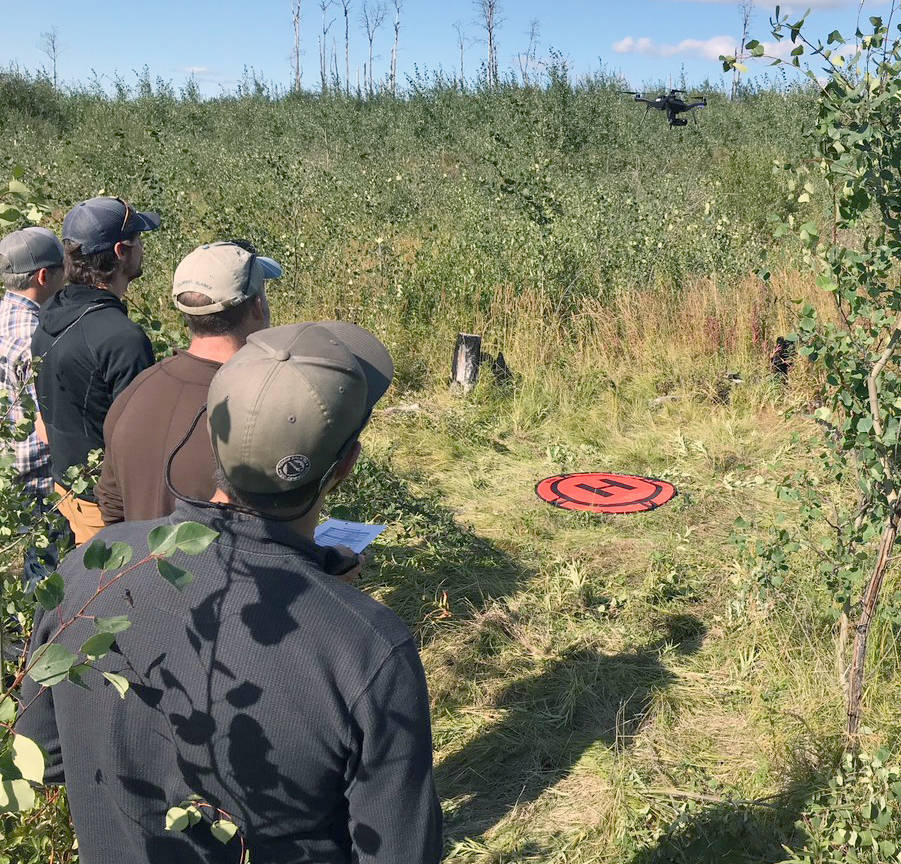If you were out at the Marsh Lake trail head in the Skilak Wildlife Recreation Area, perhaps you noticed several groups of people looking into the sky. I witnessed a few vehicles stop to see what everyone was looking at. Often wildlife draws attention here, but on that day in late August, folks were watching drones.
The 11 operators were students hoping to become part of the next generation of U.S. Fish & Wildlife Service pilots. However, these pilots won’t be sitting in an aircraft, but will instead be flying them remotely.
The students were training to operate a small quadcopter. It may look like a toy, but it is capable of carrying an array of sophisticated sensors, operating autonomously, and flying in conditions or places manned aircraft can’t. All that said, my kids still consider it a toy that I play with at work.
The students learned to how to maneuver the Unmanned Aerial System (UAS, also known as drones), operate sensors and respond to system failures that could affect their ability to control the aircraft.
Most folks have no problem maneuvering the UAS, especially if they operated a remote control toy before. If not, it can be a challenge to train your brain to steer it the correct way when it’s facing a different direction. It’s kind of like backing up a trailer using mirrors for the first time.
The UAS program within the U.S. Fish & Wildlife Service started only last year. With the millions of consumer UAS out there, it’s easy to forget how quickly they have become commonplace.
However, it was only about five years ago that the consumer and Do-It-Yourself drone industry kicked into high gear. Shortly thereafter, these inexpensive UASs were everywhere, carrying things, dropping things and taking pictures.
It didn’t take long before they were eyed by biologists, who viewed them as a tool instead of a toy. As tantalizing as these potential tools are, they are also fast flying objects relying on a responsible human and numerous complex systems working together to keep them from crashing and causing harm. What could possibly go wrong?
That is why the Federal Aviation Administration, the agency charged with administering our National Airspace, considers them aircraft. Fortunately, the Department of Interior aviation folks had been engaged with the rapidly changing technology and regulations, and provided guidance and training to those human operators.
The demand for training has outpaced the supply. The limiting factor has been the number of qualified instructors. As one of the initial remote pilots, I agreed to become an instructor to help build the program.
It has been great to see the wave of innovation and creativity in just the last couple years from our UAS pilots. Much like satellites provided ecologists with a landscape view, UASs are giving scientists local-scale, remote-sensed data.
Direct wildlife observations and measurements can change animals’ behavior, potentially affecting study results. Remote sensing instruments can often collect the same data without interaction or effect.
These inexpensive aircraft have delivered aviation and remote sensing to the masses and, with them, innovative solutions to a wide range of challenges.
Here are just a couple examples. DOI remote pilots have been onsite at the Kilauea Volcano in Hawaii for many months providing real time information on lava flows to protect resources and search for people in harm’s way.
In one instance, a UAS was used to guide an individual trapped by lava flow to safety. As tools for wild-land firefighting, UAS have time and again proved their mettle by both assisting firefighters and keeping them safe.
We utilized what we learned from last year’s pilot survey of nesting Aleutian terns here at Headquarters Lake to develop new techniques that will allow biologists to greatly increase the efficiency and quality of nest surveys.
Remote pilots on National Wildlife Refuges across the country have been pioneering new methods to survey a wide variety of wildlife. The use of UAS is energizing ecological studies by providing new data from a bird’s eye view.
You may be wondering how those students did. Everyone passed — it was almost disappointingly uneventful, not even a broken propeller! In past classes I’ve had to dive out of the way, grab the controls, and witness some dramatic crashes.
With these 11 next generation pilots, the U.S. Fish and Wildlife Service has 47 remote UAS pilots, eight of which are in Alaska. I’m confident they will continue to innovate and find creative and effective ways to conserve our wild lands.
Mark Laker is an ecologist at Kenai National Wildlife Refuge. Find more Refuge Notebook articles (1999-present) at https://www.fws.gov/refuge/Kenai/community/refuge_notebook.html.

